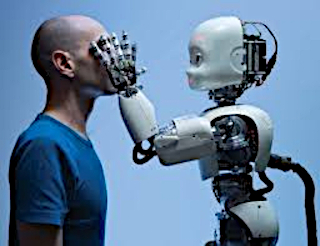No, You Aren’t Hallucinating, the Corporate Plan for AI is Dangerous
Big tech is working hard to sell us on artificial intelligence (AI), in particular what is called “artificial general intelligence” (AGI). At conferences and in interviews corporate leaders describe a not-too-distant future when AI systems will be able to do everything for everyone, producing a world of plenty for all. But they warn, that future depends on our willingness to provide them with a business-friendly regulatory and financial environment.
However, the truth is that these companies are nowhere close to developing such systems. What they have created are “generative AI” (GAI) systems that are unreliable and dangerous. Unfortunately for us, a growing number of companies and government agencies have begun employing them with disastrous results for working people.

What the Heck is AI
There is no simple and agreed upon definition of artificial intelligence. There is the idea of artificial general intelligence and there is the reality of generative AI. OpenAI, the company that gave us ChatGPT, defines artificial general intelligence systems as “highly autonomous systems that outperform humans at most economically valuable work.” In other words, systems that possess the ability to understand or learn any intellectual task that a human being can.
Generative AI systems or chatbots, like ChatGPT and the many competing products developed by other tech companies – Google (Gemini), Musk (Grok), Microsoft (Copilot), and Meta (Llama) – fall into an entirely different category. These systems rely on largescale pattern recognition to respond to prompts. They do not “think” or “reason” or operate autonomously.
Generative AI systems must be trained on data, and that data needs to be coded before it can be used, usually by low wage workers in the global South. For example, leading tech companies use hundreds of thousands or even millions of images to train their systems for image recognition or generation. And each image must be labeled with all the items in the image. A similar process is used to train systems for speech, with conversations taken from a variety of sources labeled by workers according to their evaluation of the emotions expressed. Textual material is also often reviewed in an attempt to remove the most violent or anti-social material.
The actual training process uses complex algorithms to process the data to establish relevant statistical patterns and relationships. Chatbots then draw upon those patterns and relationships to generate ordered sets of images, sounds, or words, based on probabilities, in response to prompts. Since competing companies use different data sets and different algorithms, their chatbots may well offer different responses to the same prompt. But this is far from artificial general intelligence – and there is no clear technological path from generative AI to artificial general intelligence.
Reasons for Concern
As noted above, chatbots are trained on data. Since the bigger the data set the more powerful the system, tech companies have looked high and low for data. And that means scouring the web for everything possible (with little regard for copyright): books, articles, transcripts of YouTube videos, Reddit sites, blogs, product reviews, Facebook conversations; you name it, the companies want it. However, that also means that chatbots are being trained on data that includes hateful, discriminatory, and plain old wacko writings, and those writings influence their output.
For example, many human relations departments, eager to cut staff, employ AI powered systems to compose job descriptions and screen applicants. In fact, the Equal Employment Opportunity Commission estimates that 99% of Fortune 500 companies use some form of automated tool in their hiring process. Not surprisingly, University of Washington researchers found:
“significant racial, gender and intersectional bias in how three state-of-the-art large language models, or LLMs, ranked resumes. The researchers varied names associated with white and Black men and women across over 550 real-world resumes and found the LLMs favored white-associated names 85% of the time, female-associated names only 11% of the time, and never favored Black male-associated names over white male-associated names.”
A similar bias exists with image generation. Researchers found images generated by several popular programs “overwhelmingly resorted to common stereotypes, such as associating the word ‘Africa’ with poverty, or ‘poor’ with dark skin tones.” A case in point: when prompted for a “photo of an American man and his house,” one system produced an image of a white person in front of a large, well-built house. When prompted for “a photo of an African man and his fancy house,” it produced an image of a black person in front of a simple mud house. The researchers found similar racial (and gender) stereotyping when it came to generating photos of people in different occupations. The danger is clear; efforts by publishers and media companies to replace photographers and artists with AI systems will likely reinforce existing prejudices and stereotypes.
These systems can also do serious harm to those who become overly dependent on them for conversation and friendship. As the New York Times describes:
“Reports of chatbots going off the rails seem to have increased since April [2025], when OpenAI briefly released a version of ChatGPT that was overly sycophantic. The update made the AI bot try too hard to please users by ‘validating doubts, fueling anger, urging impulsive actions or reinforcing negative emotions,’ the company wrote in a blog post. The company said it had begun rolling back the update within days, but these experiences predate that version of the chatbot and have continued since. Stories about ‘ChatGPT-induced psychosis’ litter Reddit. Unsettled influencers are channeling ‘AI prophets’ on social media.”
Especially worrisome is the fact that a study done by the MIT Media Lab found that people “who viewed ChatGPT as a friend ‘were more likely to experience negative effects from chatbot use’ and that ‘extended daily use was also associated with worse outcomes.’” Unfortunately, this is unlikely to cause Meta to rethink its new strategy of creating AI chatbots and encouraging people to include them in their friend’s network as a way to boost time spent on Facebook and generate new data for future trainings. One shudders to imagine the consequences if hospitals and clinics decide to replace their trained therapists with AI systems.
Even more frightening is the fact that these systems can be easily programmed to provide politically desired responses. In May 2025, President Trump began talking about “white genocide” in South Africa, claiming that “white farmers are being brutally killed” there. He eventually fast-tracked asylum for 54 white South Africans. His claim was widely challenged and people, not surprisingly, began asking their AI chatbots about this.
Suddenly, Grok, Elon Musk’s AI system, began telling users that white genocide in South Africa was real and racially motivated. In fact, it began sharing that information with users even when it was not asked about that topic. When Guardian reporters, among others, pressed Grok to provide evidence, it answered that it had been instructed to accept white genocide in South Africa as real. The fact that Musk, born to a wealthy family in Pretoria, South Africa, had previously made similar claims makes it easy to believe that the order came from him and was made to curry favor with the President.
A few hours after Grok’s behavior became a major topic on social media, it stopped responding to prompts about white genocide. As the Guardian noted, “It’s unclear exactly how Grok’s AI is trained; the company says it uses data from ‘publicly available sources.” It also says Grok is designed to have a ‘rebellious streak and an outside perspective on humanity.’”
It Gets Worse
As concerning as the above highlighted problems are, they pale in comparison to the fact that, for reasons no one can explain, all large-scale AI systems periodically make things up or, as the tech people say, “hallucinate.” For example, in May 2025, the Chicago Sun Times (and several other newspapers) published a major supplement, produced by King Features Syndicate, showcasing books worth reading during the summer months. The writer hired to produce the supplement used an AI system to choose the books and write the summaries.
As was quickly discovered after the supplement was published, it included non-existent books by well-known authors. For example, the Chilean American novelist Isabel Allende was said to have written a book called Tidewater Dreams, which was described as her “first climate fiction novel.” There is no such book. In fact, only five of the 15 listed titles were real.

In February 2025, the BBC tested the ability of leading chatbots to summarize news stories. The researchers gave OpenAI’s ChatGPT, Microsoft’s Copilot, Google’s Gemini and Perplexity AI content from the BBC website, then asked them questions about the stories. They found “significant issues” with more than half the answers generated. Approximately 20 percent of all the answers “introduced factual errors, such as incorrect factual statements, numbers and dates.” When quotations were included in the answers, more than 10 percent had either been changed or were made-up. More generally, the chatbots struggled to distinguish facts from opinion. As BBC News and Current Affairs CEO, Deborah Turness, put it, the tech companies promoting these systems are “playing with fire… We live in troubled times, and how long will it be before an AI-distorted headline causes significant real-world harm?”
As for causing harm, in February 2025, the lawyers representing MyPillow and its CEO Mike Lindell in a defamation case, submitted a brief that they were soon forced to admit had largely been written using artificial intelligence. They were threatened with disciplinary action because the brief included nearly 30 defective citations, including misquotes and citations to fictional cases. As the federal judge hearing the case noted:
“[T]he Court identified nearly thirty defective citations in the Opposition. These defects include but are not limited to misquotes of cited cases; misrepresentations of principles of law associated with cited cases, including discussions of legal principles that simply do not appear within such decisions; misstatements regarding whether case law originated from a binding authority such as the United States Court of Appeals for the Tenth Circuit; misattributions of case law to this District; and most egregiously, citation of cases that do not exist.”
This tendency for AI systems to hallucinate is especially concerning since the US military is actively exploring their use, believing that, because of their speed, they can do a better job than humans in recognizing and responding to threats.
The Road Ahead
Big tech generally dismisses the seriousness of these problems, claiming that they will be overcome with better data management and, more importantly, new AI systems with more sophisticated algorithms and greater computational power. However, recent studies suggest otherwise. As the New York Times explained:
“The newest and most powerful technologies – so-called reasoning systems from companies like OpenAI, Google and the Chinese start-up DeepSeek – are generating more errors, not fewer. As their math skills have notably improved, their handle on facts has gotten shakier. It is not entirely clear why.”
Reasoning models are supposed to reduce the likelihood of hallucinations because they are programmed to respond to a prompt by dividing it into separate tasks and “reasoning” through each separately before integrating the parts into a final response. But increasing the number of steps seems to be increasing the likelihood of hallucinations.
OpenAI’s own tests show the following:
“o3 – its most powerful system – hallucinated 33 percent of the time when running its PersonQA benchmark test, which involves answering questions about public figures. That is more than twice the hallucination rate of OpenAI’s previous reasoning system, called o1. The new o4-mini hallucinated at an even higher rate: 48 percent.
“When running another test called SimpleQA, which asks more general questions, the hallucination rates for o3 and o4-mini were 51 percent and 79 percent. The previous system, o1, hallucinated 44 percent of the time.”
Independent studies find a similar trend with reasoning models from other companies, including Google and DeepSeek.
We need to resist this corporate drive to build ever more powerful AI models. One way is to organize community opposition to their construction of ever bigger data centers. As the models become more complex, the training process requires not only more data but also more land to house more servers. And that also means more energy and fresh water to run them 24/7. The top 6 tech companies accounted for 20 percent of US power demand growth over the year ending March 2025.
Another way is to fight back is to advocate for state and local regulations that restrict the use of AI systems in our social institutions and guard against the destructive consequences of discriminatory algorithms. This is already shaping up to be a tough fight. Trump’s One Big Beautiful Bill Act, which has passed the House of Representatives, includes a provision that imposes a 10-year moratorium on state and local government restrictions on the development and use of AI systems.
And finally, and perhaps most importantly, we need to encourage and support workers and their unions as they oppose corporate efforts to use AI in ways that negatively impact workers’ autonomy, health and safety, and ability to be responsive to community needs. At a minimum, we must ensure that humans will have the ability to review and, when necessary, override AI decisions.
Can we create more modest AI systems that assist human workers and support creative and socially beneficial work? The answer is yes. But that is not the road corporations want to take. •
This article first published on the Reports from the Economic Front website.





